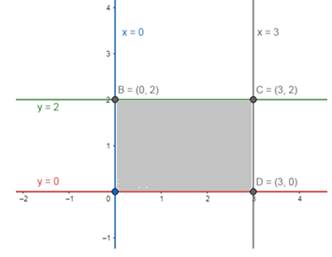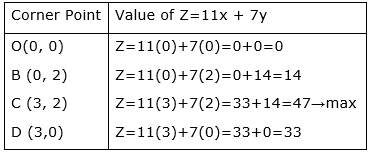Maximize the function Z = 11x + 7y, subject to the constraints: x ≤ 3, y ≤ 2, x ≥ 0, y ≥ 0.
Given:
Z=11x + 7y
It is subject to constraints
x ≤ 3, y ≤ 2, x ≥ 0, y ≥ 0
Now let us convert the given inequalities into equation.
We obtain the following equation
x ≤ 3
⇒ x=3
y ≤ 2
⇒ y=2
x ≥ 0
⇒ x=0
y ≥ 0
⇒ y=0
The region represented by x≤3:
The line is parallel to y-axis and meets the x-axis at x=3. It is clear (0,0) satisfies the inequation x≤2. So the region containing the origin represents the solution set of the inequation x≤3.
The region represented by y≤2:
The line is parallel to x-axis and meets the y-axis at y=2. It is clear (0,0) satisfies the inequation y≤2. So the region containing the origin represents the solution set of the inequation y≤2.
Region represented by x≥0 and y≥0 is first quadrant, since every point in the first quadrant satisfies these inequations.
Plotting these equations graphically, we get

The shaded region OBCD is the feasible region is bounded, so, maximum value will occur at a corner point of the feasible region.
Corner Points are O (0, 0), B (0, 2), C (3, 2) and D (3, 0)
Now we will substitute these values in Z at each of these corner points, we get

Hence, the maximum value of Z is 47 at the point (3, 2).